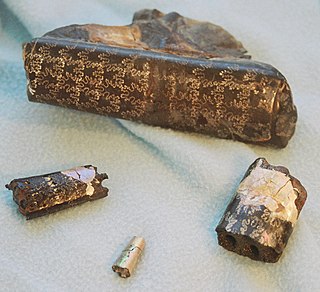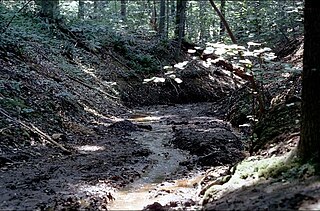
Baculites is an extinct genus of cephalopods with a nearly straight shell, included in the heteromorph ammonites. The genus, which lived worldwide throughout most of the Late Cretaceous, and which briefly survived the K-Pg mass extinction event, was named by Lamarck in 1799.

The Lance (Creek) Formation is a division of Late Cretaceous rocks in the western United States. Named after Lance Creek, Wyoming, the microvertebrate fossils and dinosaurs represent important components of the latest Mesozoic vertebrate faunas. The Lance Formation is Late Maastrichtian in age, and shares much fauna with the Hell Creek Formation of Montana and North Dakota, the Frenchman Formation of southwest Saskatchewan, and the lower part of the Scollard Formation of Alberta.

The Bearpaw Formation, also called the Bearpaw Shale, is a geologic formation of Late Cretaceous (Campanian) age. It outcrops in the U.S. state of Montana, as well as the Canadian provinces of Alberta and Saskatchewan, and was named for the Bear Paw Mountains in Montana. It includes a wide range of marine fossils, as well as the remains of a few dinosaurs. It is known for its fossil ammonites, some of which are mined in Alberta to produce the organic gemstone ammolite.
Paleontology or palaeontology is the study of prehistoric life forms on Earth through the examination of plant and animal fossils. This includes the study of body fossils, tracks (ichnites), burrows, cast-off parts, fossilised feces (coprolites), palynomorphs and chemical residues. Because humans have encountered fossils for millennia, paleontology has a long history both before and after becoming formalized as a science. This article records significant discoveries and events related to paleontology that occurred or were published in the year 1999.

The Pierre Shale is a geologic formation or series in the Upper Cretaceous which occurs east of the Rocky Mountains in the Great Plains, from Pembina Valley in Canada to New Mexico.

The Aguja Formation is a geological formation in North America, exposed in Texas, United States and Chihuahua and Coahuila in Mexico, whose strata date back to the Late Cretaceous. Dinosaur remains are among the fossils that have been recovered from the formation.
The Merchantville Formation is a geological formation in the northeastern United States whose strata date back to the Late Cretaceous, around the time of the Santonian and Campanian age. Dinosaur remains are among the fossils that have been recovered from the formation.

The Cerro del Pueblo Formation is a geological formation in Coahuila, Mexico whose strata date back to the Late Cretaceous. Dinosaur remains are among the fossils that have been recovered from the formation. The formation is believed to correlate with the Baculites reesidesi and Baculites jenseni ammonite zones, which dates it to 73.63-72.74 Ma.
The Bostobe Formation is a geological formation in Qaraghandy & Qyzylorda, Kazakhastan whose strata date back to the Late Cretaceous.

Kourisodon is an extinct genus of mosasaur. Fossils have been found from Vancouver Island in British Columbia, Canada, as well as from the Izumi Group of Japan. These finds date back to the late Santonian stage and the late Campanian to the late Maastrichtian, respectively, of the Late Cretaceous. Kourisodon was originally described as a member of the "Leiodontini", more recently as a "Clidastine".
The Marnes d’Auzas Formation is a geological Formation in southwestern France whose strata date back to the Late Maastrichtian. It is about 100 metres thick and consists primarily of marls with some interbeds of sandstones. It corresponds to sediments whose depositional environment evolved from the paralic domain at the base of the formation, towards a more continental domain in its upper part. The Marnes d’Auzas Formation was deposited in the west coast of the former Ibero-Armorican Island, which included much of France and Spain.
The Williams Fork Formation is a Campanian (Edmontonian) geologic formation of the Mesaverde Group in Colorado. Dinosaur remains are among the fossils that have been recovered from the formation, most notably Pentaceratops sternbergii,. Other fossils found in the formation are the ammonite Lewyites, neosuchian crocodylomorphs, and the mammals Glasbius and Meniscoessus collomensis.

The Ojo Alamo Formation is a geologic formation in New Mexico spanning the Mesozoic/Cenozoic boundary. Non-avian dinosaur fossils have controversially been identified in beds of this formation dating from after the Cretaceous–Paleogene extinction event, but these have been explained as either misidentification of the beds in question or as reworked fossils, fossils eroded from older beds and redeposited in the younger beds.
The Jobu Formation is a Cretaceous geologic formation of Late Cenomanian age. Dinosaur remains are among the fossils that have been recovered from the formation, although none have yet been referred to a specific genus. The oldest confirmed tyrannosaurid premaxillary tooth was recovered from the Jobu Formation. The mammal Sorlestes is also known from the formation.

The Ellisdale Fossil Site is located near Ellisdale in the valley of the Crosswicks Creek, in Monmouth County, New Jersey, United States. The site has produced the largest and most diverse fauna of Late Cretaceous terrestrial animals from eastern North America, including the type specimens of the teiid lizard Prototeius stageri and the batrachosauroidid salamander Parrisia neocesariensis. The site occurs within the basal portion of the Marshalltown Formation, and dates from the Campanian Stage of the Late Cretaceous. The site is classified as a Konzentrat-Lagerstätten resulting from a prehistoric coastal storm.

The Malargüe Group is a group of geologic formations of the Neuquén Basin of the Mendoza, Neuquén, Río Negro and La Pampa Provinces in northern Patagonia, Argentina. The formations of the Malargüe Group range in age between the middle Campanian to Deseadan, an Oligocene age of the SALMA classification, straddling the Cretaceous–Paleogene boundary, about 79 million to 30 million years in age. The group overlies the older Neuquén Group, separated by an unconformity dated to 79 Ma. The rocks of the Malargüe Group comprise both marine and continental deposits which are over 400 m (1312 ft) thick in total.
The Black Creek Group is a geologic group in North Carolina. It preserves fossils dating back to the Late Cretaceous period.
Suciacarpa is an extinct genus of asterid flowering plants in the order Cornales. It is known from the fossil species Suciacarpa starrii and Suciacarpa xiangae, both found in Western North America.
Condonella is an extinct genus of land snail in the family Urocoptidae known from the fossil species Condonella suciensis of Western North America.
The Bladen Formation is a geologic formation in North Carolina. It is known for a plethora of terrestrial and aquatic Cretaceous fossils, including dinosaurs and mosasaurs.










